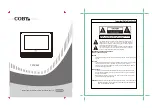
57
Operating principles
•
The hydrogenerator :
The hydrogenerator consists of a permanent magnet alternator producing a very low three
-
phase
current (0
-
40 V). This alternator technology allows for very high output, but has the disadvantage
of generating high voltages during overspeed.
•
Protection against overvoltage :
To prevent the voltage from surging over 40V, the hydrogenerator is equipped with an electronic
system that momentarily short
-
circuits the alternator during overspeed. This embedded circuit
protects the systems located downstream of the alternator.
When the hydrogenerator is working overspeed, it produces a very distinctive and audible
rumble.
It the hydrogenerator is used for a long time in this situation, the overvoltage protection could be
damaged, and is not easily repairable as casted in the resin inside the generator.
This may happen for one of the following reasons :
1 – A cable has been disconnected or the fuse has blown and the converter is no longer connected
to the batteries. The hydrogenerator is freewheeling and is no longer slowed by the
electromagnetic force. The converter is possibly turned off.
2 – The three
-
phase cable has become completely disconnected. In this case, the LEDs flash from
red, to orange and then to green, indicating that the battery is connected but that there is no power
input.
3 – A three
-
phase wire has become disconnected. In this case, the converter continues to charge
but less efficiently. The LEDS must display a constant color ranging from violet, to blue and then to
white, on which are surimposed 2 red flashes every 5 seconds.
4 – The batteries are charged or the battery capacity is too weak. The converter has finished
charging the batteries or the batteries cannot absorb enough energy to slow down the propeller.
The converter indicates this status with a green flash every 5 seconds.
5 – The boat is sailing faster than the propeller speed range and the converter is running at
maximum capacity.
•
The converter :
It transforms the alternating current coming from the alternator into a continuous current compatible
with the batteries. This voltage is regulated at several levels depending on the state of charge of
the batteries. During charging, voltage is regulated at 14.3V / 28.6V (absorption phase). When
conditions allow for fully charging the batteries, the converter regulates to a lower voltage (13.8V
/ 27.6V) to maintain the batteries without damaging them (floating phase).










































